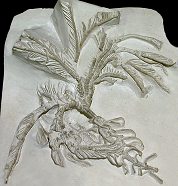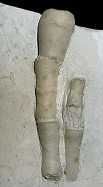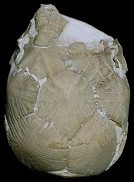 |
 |
 |
 |
| ISOCRINIDS | BOURGUETICRINIDS | UINTACRINIDS | MARSUPITIDS |
BRITISH CHALK CRINOIDS
(Sea Lilies)
| Introduction |
Complete crinoids are very scarce in the Chalk, but isolated ossicles are common and widespread. A selection of identifiable skeletal elements are shown below. A variety of crinoid forms are present; Isocrinids and Bourgueticrinids possessing the classic stalked body-plan, whilst Marsupitids and Uintacrinids lack stems and appear to have rested on the seafloor. Marsupites and Uintacrinus are important worldwide zone fossils in the Santonian. Delicate, free-roaming stemless forms (Comatulids; 'feather stars') are also present, but their remains typically fall within the realm of microfossils. (Possible articulated Comatulid).
| References |
RASMUSSEN, H.W. 1961. A monograph on the Cretaceous Crinoidea. Biologiske Skrifter udgivet af Det Kongelige Danske Videnskabernes Selskab, 12 (1).
STAINFORTH, R.M. 1938. Unitacrinus westfalicus (Schlüter) from the Yorkshire Senonian. Proceedings of the Geologist's Association, L, 1, 101-104.
WRIGHT, C. W., and SMITH, A. B. 2002. Echinoderms, in: Fossils of the Chalk (2nd Edition), Smith A. B. & Batten D.J. (Ed.s), Palaeontological Field Guide to Fossils, No. 2 , Palaeontological Association, London.